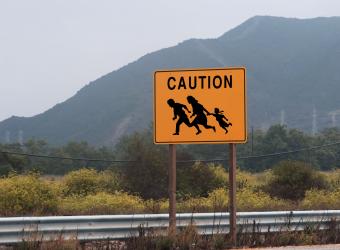Illegal Immigration & Interior Enforcement
Recent Activity
This policy brief compares existing proposals for comprehensive immigration reform by President Bush and the 109th Congress with regard to changes to lawful permanent resident (LPR) admissions, the terms and conditions of nonimmigrant visas, and policy responses to the existing unauthorized immigrant population.
Since the September 11, 2001 terrorist attacks, the United States Department of Justice has sought to engage local police in the systematic enforcement of routine civil immigration violations, marking a sea change in immigration and local law enforcement practices. This report provides the first public glimpse of how the new NCIC policy has affected on‐the‐ ground policing strategies across the country and which immigrant groups have been most heavily impacted.
This policy brief examines the flaws in the United States’ existing employer sanctions regime and proposes six types of reform that could strengthen the system: improvements to document security, document consolidation, mandatory use of employment databases, increased enforcement staffing, a revised penalty structure, and better worksite access for investigators.
This report explores the successes and failures of various attempts to create an employment verification system that reliably establishes an employee’s eligibility to work since the passage of the Immigration Reform and Control Act in 1986. Through this analysis, the author evaluates the effectiveness and potential contributions of the current system and seeks to inform proposals for future initiatives.
This brief provides a historical overview of various attempts at implementing workplace enforcement in the United States before arguing in favor of a process not unlike credit-card verification that allows employers to swipe a card at the point of hire and receive a response in real time from the Social Security Administration informing them whether an employee is authorized to work in the United States.
This report examines the sweeping changes in the way identity documents are issued and used under the REAL ID Act, an effort to enhance the security of identity documents in post-9/11 America. It takes a detailed look at how this legislation will affect document issuing agencies, state budgets, and the employment verification system, in addition to immigrants and citizens.
This report closely examines the rapid growth of government appropriations directly targeted to immigration enforcement activities since the passage of the Immigration Control and Reform Act of 1986 (IRCA). Focusing primarily on data between 1985 and 2002, authors highlight trends in the overall immigration enforcement spending as well as in specific activities.
An estimated 10.3 million unauthorized migrants were living in the U.S. in 2004. Jennifer Van Hook, Frank Bean, and Jeff Passell report on who they are, where they live, the work they do, and their levels of education and poverty.



![cover_comp[1]](https://www.migrationpolicyinstitute-europe.com/sites/default/files/styles/publication_thumbnail/public/pub_covers/cover_comp%5B1%5D.gif?itok=Gmo7-f_r)






